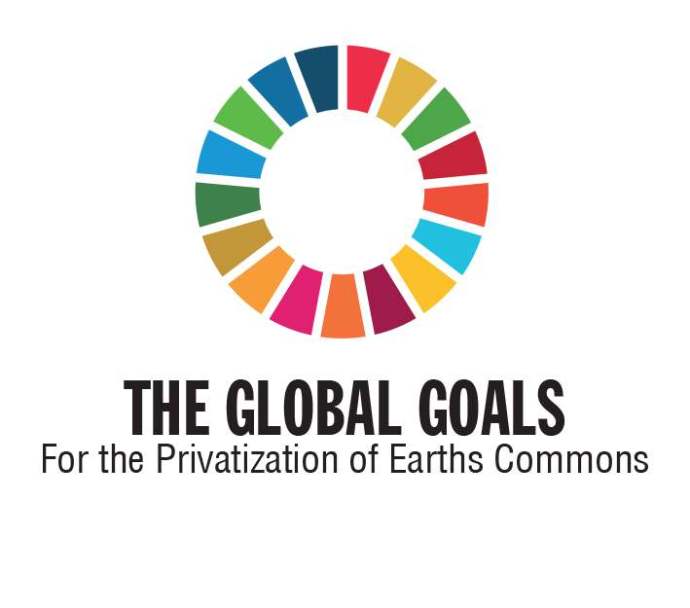May 06
20162
350.org / 1Sky, Avaaz, Bill & Melinda Gates Foundation, Ceres, Foundations, Greenpeace, Non-Profit Industrial Complex, NoVo Foundation, Rockefeller Brothers Fund, Rockefeller Foundation, Whiteness & Aversive Racism
#WeHaveAPlan 350 Annie Leonard Avaaz Ceres Earth Economics Indigenous Rights Natural Capital NoVo Payments for Ecosystems Services (PES) privatization Purpose Tides UN Sustainable Development Goals (SDGs) WBCSD
Earth Economics
Running with Bad Company
May 6, 2016
By Jay Taber
Earth Economics–founded by Greenpeace USA Executive Director Annie Leonard–is a partner with the Coalition for Environmentally Responsible Economies (CERES), which is in turn a partner of the World Business Council for Sustainable Development (WBCSD). CERES funders are associated with Goldman Sachs, JPMorgan Chase, Citigroup, Morgan Stanley and Bank of America. WBCSD is part of a Wall Street strategy to dislodge the United Nations Center on Transnational Corporations, and prevent enforceable rules governing the operations of multinational corporations.
May, 2013: “CalSTRS CEO Jack Ehnes, Generation Investment Management Co-Founder David Blood (formerly of Goldman Sachs) and 350.org’s Bill McKibben have a lively conversation about how investors can influence the transition to a low-carbon economy.” Ehnes also serves on the Ceres board of directors.
As noted in The Social Capitalists–Part VIII of an investigative report documenting the corruption of the non-profit industrial complex by Wall Street–researcher Cory Morningstar revealed that one third of the CERES network companies are in the Fortune 500, and that since 2001, CERES has received millions from Wall Street corporations and foundations. Further, she observed that CERES president Mindy Lubber is a promoter of so-called “sustainable capitalism” at Forbes. Bill McKibben (founder of 350) was an esteemed guest of CERES conferences in both 2007 and 2013.
1Sky, which merged with 350 in 2011, was created by the Clinton Foundation and the Rockefeller Brothers Fund. Betsy Taylor of 1Sky/350 is on the CERES board of directors. In 2012, Bill McKibben and Peter Buffett (oil train tycoon Warren Buffet’s son) headlined the Strategies for a New Economy conference. Between 2003 and 2011, NoVo (Buffet’s foundation) donated $26 million to TIDES Foundation, which in turn funds CERES and 350. Suzanne Nossel, former Deputy Assistant Secretary of State under Hillary Clinton, is on the TIDES board of directors.
As reported in Axis of Evil, the 2016 Investor Summit on Climate Risk—co-hosted by CERES, the United Nations Foundation and the United Nations Office for Partnerships—focused on the ‘New Economy’ unveiled by the financial elite at COP21. The ‘New Economy’–promoted by CERES and the Wall Street-funded social media marketing agencies Avaaz, Purpose and 350—forms the core of the UN Sustainable Development Goals (SDGs) promoted by Bill Gates, Jeremy Heimans (Avaaz & Purpose), and Bill McKibben (350). The ultimate target of the SDGs is the privatization of Indigenous and public resources worldwide.
In Building Acquiescence for the Commodification of the Commons under the Banner of a “New Economy”—Part XII of Morningstar’s investigative report—she says, the goal to commodify the commons under what has come to be known as ‘payment for ecosystem services’ and ‘Natural Capital’ will look to the private sector for investment. “The scheme,” she remarks, “promises corporations, private investors and the world’s most powerful financial institutions both ownership and control (i.e. expansion of power) of Earth’s natural resources.”
“The implementation of payment for ecosystem services,” Morningstar observes, “will create the most spectacular opportunities that the financial sector has ever witnessed.” This new mechanism for generating profits for the wealthy, she says, represents “the commodification of most everything sacred,” and “the privatization and objectification of all biodiversity and living things that are immeasurable, above and beyond monetary measure”—a mechanism that, “will be unparalleled, irreversible and inescapable.”
In Hijacking the Environmental Movement, I wrote that the ‘New Economy’ privatization cheerleaders, i.e. 350, Avaaz and CERES, all have fundamental ties to Wall Street moguls and finance sector criminals, and are “currently pressing for changes in international law that would give the finance sector carte blanche in privatizing all of nature.” What this so-called ‘sustainable capitalism’ is in reality sustaining, I observed, “is totalitarian corporate control of world governance and human survival.” Earth Economics, initially founded by TIDES, is a key player in promoting this scheme.
Earth Economics: “We Take Nature Into Account”
As I noted in Architects of the Final Solution, “For ubercapitalists like Bill Gates and their sycophants like William Jefferson Clinton, who promote the false hope of neoliberal globalization, terminating the collective ownership of indigenous nations in exchange for totalitarian corporate control of the planet’s resources is a dream coming true.”
[Jay Thomas Taber is an associate scholar of the Center for World Indigenous Studies and a contributing editor of Fourth World Journal. Since 1994, he has served as communications director at Public Good Project, a volunteer network of researchers, analysts and journalists defending democracy. As a consultant, he has assisted Indigenous peoples in the European Court of Human Rights and at the United Nations.]

















































